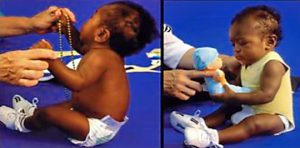In the bad old days, a child with cerebral palsy who attained any level of independent function was considered “Good Enough”. Fortunately, times have changed and the standards must be set higher for all children with Cerebral Palsy.

The image on the left is the most common type of neurological problem seen in an NICU Follow-up Clinic. The infant is being supported in a sitting position and simultaneously offered some beads to play with. Now here is Infant Development 101:
- The head is held extended backwards because the neck muscles are too weak to support the heavy head
- The shoulders are hunched up and the tone in the arms increased to try to help support the head
- The back is rounded and the baby is balanced on the posterior pelvis – again because the muscles are weak
- The effort of trying to get to the sitting position tightens all the muscles, bringing the knees up – if we could look inside the cute shoes, the ankles would be up and the toes curled
All of these signs are common with low tone hypotonia. Over the first year or so of life, this pattern of movement will either resolve completely or progress to cerebral palsy. Babies are little learning machines and they will respond to novelty with great interest – this little baby is trying so hard to get at those beads. Unfortunately, whatever they do and however they move, will wire in as their own, unique movement pattern. I vote for the position on the right hand side!
The changes in tone in the photo on the left are “activity dependent” at this point in development. The image on the right is on the same day, a few minutes later. The only change is putting on a Wunzi from TheraTogs. With the extra trunk support, the infant can sit with a good base of support. The activity dependent tone is gone!!!! The head is central, the arms, hands and legs are relaxed and the infant is actively exploring a toy, using both hands. You do not need to have a MD, PT or OT degree to tell that the position that has good form will allow the child to develop good functional habits. The position that has bad form can only lead to progressive increased tone and abnormal functional patterns. Children with cerebral palsy have damaged motor control and this means that they cannot, on their own, self-correct bad form.